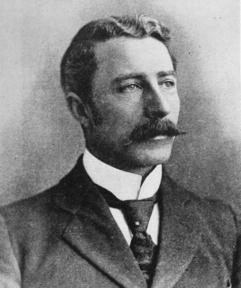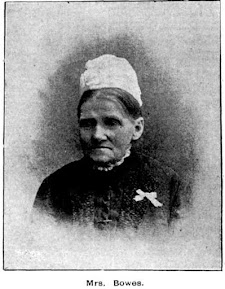Recognition long overdue
Today's blog is about the other Government Architect who calls Rookwood "home". If you are in the Sydney CBD you wander past buildings he has designed or added to frequently This man is soon to have his name shining deservedly once more.
GEORGE McRAE
George was born in Edinburgh in September 1857 the eldest child of Duncan, a joiner journeyman and his wife Mary. (For clarification a joiner journeyman is a fully qualified worker who had completed an apprenticeship but worked on a daily rate for another person as opposed to a "master" who employed others).
McRae attended George Watson's College, one where children from less advantaged backgrounds could receive quality education. Once he graduated he joined George Beattie and Sons, Architects, Edinburgh where he learnt on the job about the finer aspects of building design.
George McRae cicca. 1890 - courtesy of Wikipedia
George arrived in Sydney in 1884, (with his parents and siblings), as a highly skilled man and was appointed Assistant Architect in the City Architect’s office almost immediately. He became City Architect and City Building Surveyor in 1889. He held this position until 1897, when he was appointed Principal Assistant Architect to Walter Vernon, the Government Architect at the time.
In 1912 he succeeded Vernon as New South Wales Government Architect.
George McRae was responsible for the design of many buildings in Sydney and other places, several of which still survive and are heritage-listed.
One of his earliest works was the completion of the first stage of the Sydney Town Hall in the year of his arrival, followed by the Corn Exchange, Sussex Street, Sydney; built by City Council in 1887 and attributed to McRae.
Corn Exchange Building - courtesy of Wikiwand
In 1888, George was given the ambitious project of the Queen Victoria Building; one of the iconic buildings of Sydney due no doubt to its huge size. He produced four individual designs for the project and his Romanesque Revival plans were chosen. He utilised the latest engineering systems to produce his masterpiece with its barrel form roof. Construction started in 1893 and was completed in 1898.
QVB building - courtesy Wikipedia
Detail of stained glass windows - outside; author's own.
The magnificent dome - QVB - author's own
Detail from stained glass window showing McRae's "moniker" - author's own
McRae, a quiet hard working man, had few interests outside of his work. He married Katie Emily Prescott in 1895 and they went on to have three children.
Further designs included:-
Additions to the Colonial Treasury Building, Bridge Street, Sydney 1896;
Rozelle Tram Depot, New South Wales, 1904;
Completion of the first wing of Jenolan Caves House as well as the second and third; final completion in 1914;
Former Sydney City Markets, Ultimo Road, Haymarket, 1910;
Education Department Building 1912;
Parcels Post Office 1913;
Former Parcels Post Office - 1913 - courtesy of wikipedia
Taronga Zoo lower entrance, top entrance, and Indian elephant house 1916;
His final design in 1923 was for St James railway station, Sydney.
George had reached the compulsory retirement age in of 65 in 1923 but although requests were made for an exemption to the rules, he reluctantly retired that year.
His wife returning to their home in the eastern suburbs of Sydney on Sunday afternoon the 16th June 1923, discovered George lying in bed with an automatic revolver in his right hand and a bullet wound above his right ear. He had been in ill health for some time and was thought to be suffering from pneumonia. A sad end to a glittering career.
McRae's funeral was held on 18 June 1923 at Rookwood Cemetery and was attended by a large number of people from the Public Works Department and other government departments. He was survived by his wife, son and a daughter. His unmarked grave in the old Presbyterian Section near the large Fraser Mausoleum, contains his parents and his daughter Audrey who predeceased him in 1906.
George McRae's burial plot in Rookwood - author's own
The Hidden Sculpture exhibition has been conducted for many years by the Rookwood General Cemetery where within the Anglican section artistic works are "hidden" amongst the various headstones along a predetermined route. Each year the programme donations go towards restoration of the grave of a "significant" person or project. In the past this has been for Louisa Lawson, the old Gravedigger's Hut and the former ranger of the Cemetery, Aaron Burton. In 2019 it was decided to honour George McRae with a new Nameplate and Storyboard from proceeds from the 2020 Hidden Sculpture programme. Unfortunately Hidden was cancelled for two years due to covid but I am happy to announce that George will be getting the recognition he deserves soon.
The 2022 Hidden Sculpture exhibition will be held within the grounds of Rookwood Cemetery from 10 September to 9th October 2022. There will be curated tours, history tours, self guided tours as well as a public photography competition, family day and more.
Please see the following link for information.
HIDDEN - A Rookwood Sculpture Walk (hiddeninrookwood.com.au)
If attending on the weekends, please call by the Friends of Rookwood information tent and collect a programme for $5 (as well as information about their tours and mission), the proceeds are going towards a good cause.
There are many references to George via Trove or a simple Google search.
Thank you George McRae for your glorious designs, they will live on for many years.
If able please leave any comments here or go to the Facebook group page which you can find by searching rookwoodcemeterydiscoveries and leave a comment there.

_Corn_Exchange%20-%20wikiwand.jpg)









Beautiful story
ReplyDeleteYes and his gravesite will soon be restored with a suitable story board
Delete